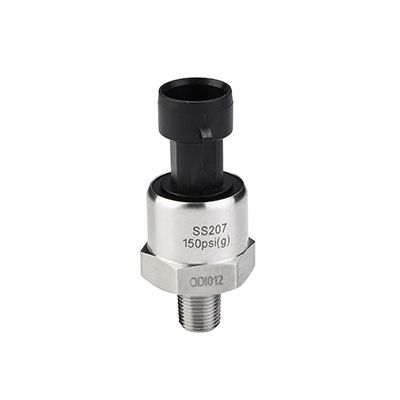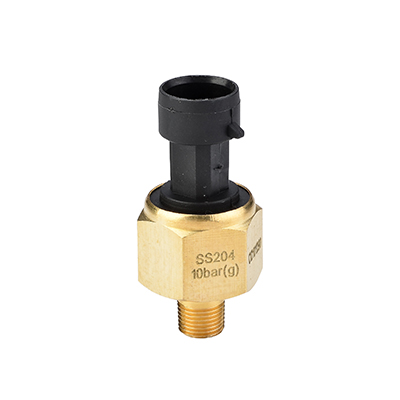Function:
Automotive oil pressure sensor is used to detect the oil pressure, send an alarm signal when the pressure is low. The light on the dashboard will turn on when the oil pressure is not large enough. Generally, the oil pressure fault alarm may caused by oil sensor plug failure, not enough oil, oil pump filter clogged, oil pump damage.
Feature:
Typical pressure connection:1/8"NPT; pressure range: 15psi, 30psi, 50psi, 75psi, 100psi; working temperature:-20 to 105deg C
 SS207 series oil pressure sensor
SS207 series oil pressure sensor
SS207 series oil pressure sensor is the one of the most mature product in Sendo, it is OEM tested, with high accuracy, long term stability, good repeatability, has been wildly used in automotive oil system, automotive AC system, automotive brake system and other car security system. available with range 15psi, 30psi, 50psi, 75psi, 100psi, 150psi.
 SS204 series electric oil pressure sensor
SS204 series electric oil pressure sensor
SS204 series electric oil pressure sensor is designed for oil pressure monitoring, it sends the oil pressure information to the car's computer, which then controls the related lights and gauges. It uses piezoresistive silicon chip as sense element and combing with special designed PCB, able to working from -20 to 105degC.
SS208 series engine oil pressure sensor is available with pressure 1bar, 2bar, 3.5bar, 5bar, 7bar, 10bar, typical with 1/8NPT connection and 0.5-4.5V signal. It is used as an actuator which directly activates the oil warning light in driver dashboard when the oil pressure in the engine will fall below the preset critical level or brings a signal to the ECU (engine control unit), so to be warned about low pressure of engine oil and prevent damage to the engine
Furcher Read:
The oil system
Inside your car's engine motor oil plays a vital role when it comes to lubricating, cooling and cleaning. A problem with any one of these three can have major consequences for the engine. Before we can understand the role of the oil pressure sensor we need to understand how oil works inside the engine.
Lubrication for beginners
To begin with consider lubrication. Inside the engine power is converted into rotary motion which is used to drive the car forwards (or backwards). In very simplified terms pistons are forced up and down inside the cylinder when the gasoline and a mixture are ignited in the combustion chamber. The m of the piston is then converted to rotary motion by the movement of the crankshaft. In this simple case we have two sets of components that need lubricating.
The first of these, the pistons need oil to prevent them from coming into direct contact with the cylinders they slide up and down in. Even though their allies in the car's engine and tough if they were to rub against each other they would soon become damaged and there will also be a lot less efficient that is why oil is needed to provide a cushion for them to glide over. Oil also lubricates the bearings inside the crankshaft. Again, this stops the bearings from wearing out and increases the efficiency as they are used to drive the crankshaft and change the linear motion coming from the pistons into rotary motion that can be used to turn the wheels.
Mor oil cooling
Next we can consider cooling. The engine gets extremely hot. It has a cooling system consisting of water and antifreeze, known as coolant. Coolant is circulated around the engine penetrating through holes drilled in the engine for this purpose. As it travels it is heated up and in this way extracts some of the heat. Then it is pumped to the radiator where it is spread over a very large surface area so it can be cooled by the airflow coming in from the grill.
However, the coolant cannot go inside the engine. Water is a poor lubricant and it does not mix with oil and this is why oil is also used to cool inside the engine were coolant cannot go. In order to lubricate the oil has to coat all of the services where components might otherwise touch each other, as search it is spread over a large area inside the engine. Surface area is critical in the transfer of heat, therefore the larger the surface area that is covered the more heat can be absorbed. In this way motor oil gets to remove a lot of heat from inside the engine before falling down into the oil sump where it is cooled before being recirculated. Some high-performance engines have a dedicated unit called an oil cooler just for this purpose.
Motor oil cleans
Finally modern motor oils containing additives to help them clean the engine. Without these cleaning chemicals a black slurry would collect on the internal surfaces and this does two things. First it hinders the flow of oil and therefore reduces the oil pressure. Second it decreases the area that the oil comes into contact with and therefore decreases the amount of heat the oil can extract. It is possible for an engine to get so hot that it is parts become welded together this is one of the dire consequences from a lack of oil and oil pressure. Most motor oils are called synthetics because they are man made, what this really means is that they are man made from a base of mineral oil. Pure synthetic oil is extremely expensive and only used in industrial applications. However, because it is so important it’s a good idea to buy the best motor oil you can afford. Don’t choose a cheap synthetic oil change to save a few dollars, it could cost a lot more in the long run.
Under pressure!
For all of this to work the oil has to be kept under pressure. It cannot just trip through the engine and its own leisurely pace it must be moved quickly. By keeping the oil pressurised it provides the necessary resistance needed to lubricate the moving parts, so it is not swept away when the forces in the engine trying push these components against each other. It also needs to be moved to make sure it can extract enough heat. A constant supply of core oil is needed to do this. As the oil is circulated by the automotive oil pump it is passed through an engine oil pressure sensor, this checks the pressure is within the manufacturer's recommended limits and sends a signal to the oil pressure gauge warning light on the dashboard to notify the driver there is a problem. Any problems relating to low oil pressure should be fixed immediately never continue to drive when your car is either too hot or has low oil pressure. If in doubt always seek professional advice.
 SS207 series oil pressure sensor
SS207 series oil pressure sensor
 SS204 series electric oil pressure sensor
SS204 series electric oil pressure sensor